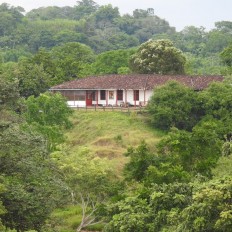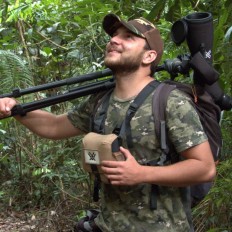Top species
- Northern Screamer (Chauna chavaria)
- Blue-billed Curassow (Crax alberti)
- Great Potoo (Nyctibius grandis)
- Common Potoo (Nyctibius griseus)
- Collared Plover (Anarhynchus collaris)
- Boat-billed Heron (Cochlearius cochlearius)
- Whistling Heron (Syrigma sibilatrix)
- Green Ibis (Mesembrinibis cayennensis)
- King Vulture (Sarcoramphus papa)
- Gray-headed Kite (Leptodon cayanensis)
- Crane Hawk (Geranospiza caerulescens)
- Gray-lined Hawk (Buteo nitidus)
- American Pygmy Kingfisher (Chloroceryle aenea)
- Pied Puffbird (Notharchus tectus)
- Gray-cheeked Nunlet (Nonnula frontalis)
- Yellow-throated Toucan (Ramphastos ambiguus)
- Channel-billed Toucan (Ramphastos vitellinus)
- Cinnamon Woodpecker (Celeus loricatus)
- Blue-and-yellow Macaw (Ara ararauna)
- Chestnut-backed Antbird (Poliocrania exsul)
- White-bearded Manakin (Manacus manacus)
- Southern Bentbill (Oncostoma olivaceum)
- Slate-headed Tody-Flycatcher (Poecilotriccus sylvia)
- Black-headed Tody-Flycatcher (Todirostrum nigriceps)
- Masked Yellowthroat (Geothlypis aequinoctialis)
- Large-billed Seed-Finch (Sporophila crassirostris)
List up to ca. 25 species that:
• have a limited distribution range and/or are rare on a global level
• are most sought-after by birdwatchers at this site
• and are relatively easy to see at this site (year-round or seasonally)
| Northern Screamer (Chauna chavaria) | |
| Blue-billed Curassow (Crax alberti) | |
| Great Potoo (Nyctibius grandis) | |
| Common Potoo (Nyctibius griseus) | |
| Collared Plover (Anarhynchus collaris) | |
| Boat-billed Heron (Cochlearius cochlearius) | |
| Whistling Heron (Syrigma sibilatrix) | |
| Green Ibis (Mesembrinibis cayennensis) | |
| King Vulture (Sarcoramphus papa) | |
| Gray-headed Kite (Leptodon cayanensis) | |
| Crane Hawk (Geranospiza caerulescens) | |
| Gray-lined Hawk (Buteo nitidus) | |
| American Pygmy Kingfisher (Chloroceryle aenea) | |
| Pied Puffbird (Notharchus tectus) | |
| Gray-cheeked Nunlet (Nonnula frontalis) | |
| Yellow-throated Toucan (Ramphastos ambiguus) | |
| Channel-billed Toucan (Ramphastos vitellinus) | |
| Cinnamon Woodpecker (Celeus loricatus) | |
| Blue-and-yellow Macaw (Ara ararauna) | |
| Chestnut-backed Antbird (Poliocrania exsul) | |
| White-bearded Manakin (Manacus manacus) | |
| Southern Bentbill (Oncostoma olivaceum) | |
| Slate-headed Tody-Flycatcher (Poecilotriccus sylvia) | |
| Black-headed Tody-Flycatcher (Todirostrum nigriceps) | |
| Masked Yellowthroat (Geothlypis aequinoctialis) | |
| Large-billed Seed-Finch (Sporophila crassirostris) |
Masked Yellowthroat (Geothlypis aequinoctialis) was added by Mathias Ritschard (Admin) (2021-08-31 00:35:15)
Southern Bentbill (Oncostoma olivaceum) was added by Mathias Ritschard (Admin) (2021-08-31 00:34:50)
Striped Cuckoo (Tapera naevia) was deleted by Mathias Ritschard (Admin) (2021-08-31 00:34:14)
Blue-and-yellow Macaw (Ara ararauna) was added by El Roble Birding (2021-08-02 22:40:43)
Whistling Heron (Syrigma sibilatrix) was added by El Roble Birding (2021-08-02 22:38:50)
White-bearded Manakin (Manacus manacus) was added by El Roble Birding (2021-08-02 22:37:43)
Slate-headed Tody-Flycatcher (Poecilotriccus sylvia) was added by El Roble Birding (2021-08-02 22:37:30)
Gray-lined Hawk (Buteo nitidus) was added by El Roble Birding (2021-08-02 22:36:58)
Striped Cuckoo (Tapera naevia) was added by El Roble Birding (2021-08-02 22:36:18)
Common Potoo (Nyctibius griseus) was added by El Roble Birding (2021-08-02 22:35:33)
Great Potoo (Nyctibius grandis) was added by El Roble Birding (2021-08-02 22:35:20)
Collared Plover (Anarhynchus collaris) was added by El Roble Birding (2021-08-02 22:34:33)
Gray-headed Kite (Leptodon cayanensis) was added by El Roble Birding (2021-08-02 22:33:47)
King Vulture (Sarcoramphus papa) was added by El Roble Birding (2021-08-02 22:33:02)
Large-billed Seed-Finch (Sporophila crassirostris) was added by El Roble Birding (2021-08-02 22:32:00)
Chestnut-backed Antbird (Poliocrania exsul) was added by El Roble Birding (2021-08-02 22:31:32)
Crane Hawk (Geranospiza caerulescens) was added by El Roble Birding (2021-08-02 22:30:55)
Northern Screamer (Chauna chavaria) was added by El Roble Birding (2021-08-02 22:30:14)
American Pygmy Kingfisher (Chloroceryle aenea) was added by El Roble Birding (2021-08-02 22:30:00)
Black-headed Tody-Flycatcher (Todirostrum nigriceps) was added by El Roble Birding (2021-08-02 22:29:02)
Cinnamon Woodpecker (Celeus loricatus) was added by El Roble Birding (2021-08-02 22:28:39)
Channel-billed Toucan (Ramphastos vitellinus) was added by El Roble Birding (2021-08-02 22:28:11)
Yellow-throated Toucan (Ramphastos ambiguus) was added by El Roble Birding (2021-08-02 22:27:59)
Boat-billed Heron (Cochlearius cochlearius) was added by El Roble Birding (2021-08-02 22:27:36)
Pied Puffbird (Notharchus tectus) was added by El Roble Birding (2021-08-02 22:27:11)
Green Ibis (Mesembrinibis cayennensis) was added by El Roble Birding (2021-08-02 22:26:45)
Blue-billed Curassow (Crax alberti) was added by El Roble Birding (2021-08-02 22:26:12)
Gray-cheeked Nunlet (Nonnula frontalis) was added by El Roble Birding (2021-08-02 22:25:56)



